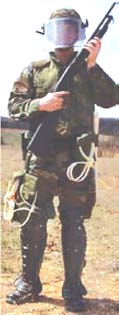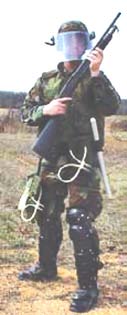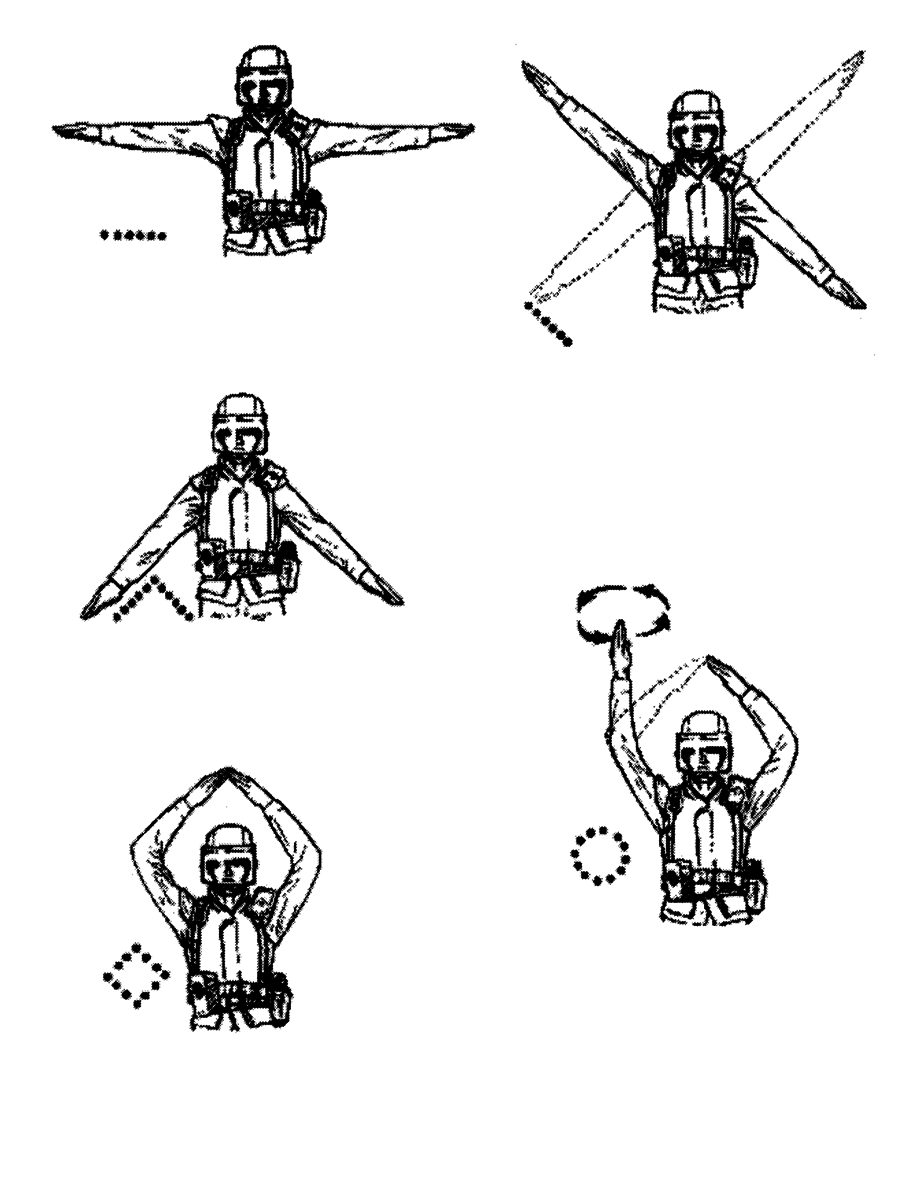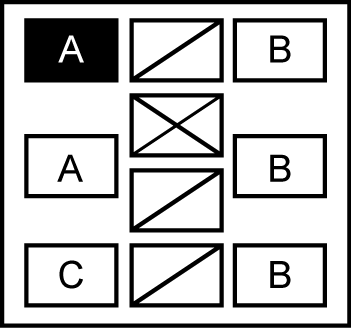6-17. Four elements make up the basic crowd control formation. They are as
follows:
z
Base element. The base element is made up of two ranks. The first
rank is shield holders, while the second rank contains the NLW. This
is the front line of the formation.
z
Support element. The support element forms up in a column
formation behind the base element and has a variety of uses. It may
be used to replace base element members as needed, provide lateral or
direct support, or perform extraction team operations. The support
element helps the base element by performing the following three
essential tasks:
General support. The general-support element is formed from
an uncommitted squad in the platoon (generally the 2d squad).
When a company is tasked as the control force element, one of the
platoons becomes the general-support element. The element is in a
column formation centered on and behind the main formation.
From this formation, the general-support element can move to
lateral or direct support, as needed.
Lateral support. The lateral-support element is used to protect
the flanks of the formation. This is done by moving a set number
of teams forward from the general-support element or by using the
18 April 2005
FM 3-19.15
6-5
Civil Disturbance Formations
end teams in the formation; however, this will make your
formation smaller. Once in position, these teams become part of
the formation, with their riot shields facing the flanks of the
formation.
Direct support. When direct support is ordered, the
general-support element moves forward as they form their own
formation. While moving forward, the squad and team leaders
from the control force formation step back and allow the riot shield
holders from the support element to step behind riot shield
holders of the original formation. This allows the support riot
shield holders to form up between and behind the riot shield
holders of the original formation. Now there are two lines of riot
shield holders between the crowd and NLW firers. This formation
is the strongest of the formations and requires more planning and
practice to master.
z
Command element. The command element contains several
different members. A general configuration for the command element
is the platoon leader, the PSG, a radio operator, a video recorder
operator (if required), and an interpreter (if required). This element
does not have a fixed location within the formation and moves about
as needed.
z
Lethal overwatch element. The lethal overwatch element is a team
formed from reserve security forces.
6-18. The reserve support element is not part of the control force formation
until it is brought forward from the rally point to join the formation. It
remains until released by the formation commander. Lethal overwatch teams
are formed from the reserve force. Once lethal overwatch teams are deployed
and in position, they are under the control of the formation commander.
Communication between the lethal overwatch team and the formation
commander is a priority because he approves target selection and
engagement.
WEAPON POSITIONS
6-19. At the commander’s discretion, members of the control force formation
may carry their weapons in any of the positions prescribed in FM 3-21.5.
However, the primary method of carrying weapons in the control force
formation is at the safe-port position (see Figure 6-3). It allows the soldier to control both ends of the weapon while moving in and out of the formation and
advancing on the crowd.
6-20. High-port position (see Figure 6-3) is a position of complete readiness. It is used whenever troops are in contact with a crowd that is showing resistance or not withdrawing. This is a tiring position and is hard to maintain for
extended periods. Commanders must rest their troops at every opportunity by
using less tiring positions.
6-6
FM 3-19.15
18 April 2005


Civil Disturbance Formations
Safe-port arms
High-port arms
Figure 6-3. Weapons Positions
COMMANDS
6-21. Commands are given to the control force formation orally or with
hand-and-arm signals. Oral commands for the on-guard position are given in
one count. All other commands are given in two counts, a preparatory
command followed by a command of execution. However, oral commands
cannot be relied on completely, so commanders must plan to use hand-and-
arm signals too. When vehicles are part of the formation, radios become an
alternate method for relaying commands. To improve communication,
commanders may use hand-and-arm signals (see Figure 6-4, page 6-8) with oral commands. The basic commands used in control force formations are
outlined in Table 6-1, page 6-9. These commands can be added to or combined to form more complex commands, therefore forming more complex formations.
MOVEMENTS
6-22. Control force formations move in the same manner as regular
formations. This allows the commander to more precisely maneuver the
formation by commanding the number of steps it should move and in what
direction, such as “Five Steps, Forward March.” The normal rate of march for
entering and leaving a control force formation is double-timing. The half-step march is used when the formation is in direct contact with the crowd. This
slows the formation down and allows for better command and control. The
squad and team leaders echo preparatory commands and provide cadence
while in control force formations.
INTERVAL AND DISTANCE
6-23. Interval is the lateral space between elements. Distance is the space
between elements in a column. The usual interval and distance between
soldiers in control force formations is 30 inches. The interval and distance can be adjusted based on METT-TC. If the crowd has to be physically pushed back,
a close interval is preferred. This allows the riot shields to be overlapped,
creating a stronger wall. During peaceful demonstrations, the interval could
18 April 2005
FM 3-19.15
6-7

Civil Disturbance Formations
increase to double arm width, allowing the formation to cover more area and
still control the crowd. The interval and distance could change several times
during the course of operations before the crowd is dispersed.
Line
Raise both arms from the sides until
they are horizontal. The arms and
Echelon (Right or Left)
hands should be extended with the
palms down.
Extend one arm 45° above the
horizontal and the other 45° below
the horizontal. The arms and
hands should be extended. The
upper arm shows the direction of
the echelon when the commander
faces the troops.
Wedge
Extend both arms downward and to the
sides at a 45 ° angle. The arms and hands
should be extended with the palms down
and in.
Circular
Give the diamond signal. Then
give a circular motion with the right
hand.
Diamond
Extend both arms above the head.
Bend the elbows slightly, and
touch the fingertips together.
Figure 6-4. Hand-and-Arm Signals
6-8
FM 3-19.15
18 April 2005
Civil Disturbance Formations
Table 6-1. Basic Commands
Commands
Command
Given by
Purpose
for
Platoon On Line
Platoon leader and/or commander
To form a line formation.
Platoon Wedge
Platoon leader and/or commander
To form a wedge formation.
Platoon Echelon
Platoon leader and/or commander
To form an echelon formation.
Platoon Diamond
Platoon leader and/or commander
To form a diamond formation.
Platoon Circle
Platoon leader and/or commander
To form a circular formation.
Formations
Move
Platoon leader and/or commander
As a command of execution.
NOTE: The platoon leader and/
or commander also identifies
the location for the formation
by pointing his arm to the
desired location for the
formation.
General Support
Platoon leader and/or commander
To place a specified unit in the
rear of the base element.
Lateral Support
Platoon leader and/or commander
To place support elements on the
left or right flank of the base
element.
Direct Support
Platoon leader and/or commander
To move support elements
Support
forward to strengthen the base
element.
Open
Extraction team leader
To open a space in the formation.
Up
Extraction team leader
To inform the extraction team to
start moving back to the main
formation.
Weapon System
Platoon leader and/or commander
To ready NL gunners to fire
Gunners, Number
weapons; for example, M203
of Rounds, Type
gunners, three rounds, area
of Round, and
target, prepare to fire.
Prepare to Fire
Fire
Shield Down
NL gunners
To tell riot shield holders to get
down on one knee and lower the
riot shield to the ground.
Shield Up
NL gunners
To tell riot shield holders to stand
and raise the riot shield.
Port Arms
Platoon leader and/or commander
To use when not in contact with
the crowd.
High Port
Platoon leader and/or commander
To tell NL gunners what position
Weapons
to hold their weapons in while the
formation is in physical contact
with the crowd. This allows for
rapid targeting and firing of NL
munitions.
18 April 2005
FM 3-19.15
6-9

Civil Disturbance Formations
EXTRACTION TEAM OPERATIONS
6-24. The extraction team is a squad (see Figure 6-5) that is generally formed from the support element, but could also be formed from reserve security
forces. Once the team is formed, it is OPCON to the formation commander
until the team’s mission is complete and it returns to the rear of the
formation. This team provides the riot control formation with the means to
employ NL and lethal cover forward of the formation. It also provides the
formation with the ability to remove and detain rioters downed by munitions.
Figure 6-5. Extraction Team Formation
The extraction team—
z
Extracts vehicles or personnel that are in immediate danger from the
crowd.
z
Detains and escorts downed rioters to the rear of the formation.
z
Restrains and searches subjects.
z
Covers confined or congested areas where a full riot control formation
cannot be inserted.
6-25. The extraction team is usually a squad. While the recommended
distance for deploying the extraction team from the control force formation is no farther than 10 meters, this may change based on METT-TC. The control
formation protects the extraction team and provides immediate support, if
necessary.
6-26. The extraction team may deploy from anywhere within the formation.
When given orders to deploy, the squad leader of the extraction team gives the formation commands, identifies at least two personnel in the squad to conduct
the search and apprehension of the subject, and leads the squad to the base
line of the formation. He then extends his arm between the two riot shield
holders and commands, “Open,” while tapping the riot shield holders on the
side of the shoulder. The two riot shield holders take one step backward and
one step to the right or left. This clears a path for the extraction team. The extraction team leader then states the number of personnel leaving the
formation, such as “ Ten security personnel leaving.” As the last extraction team member exits the formation he states, “Last Man.” The two riot shield
holders then return to their original position in the formation. The adjacent
base element squad and/or team leaders pass the number of personnel in the
team through the formation.
6-27. As the extraction team approaches an instigator or incapacitated
demonstrator, the riot shield holders envelop the target and face in the
6-10
FM 3-19.15
18 April 2005
Civil Disturbance Formations
direction of the nearest threat. NL gunners on the left and right cover their
respective areas. The search and apprehension team immediately controls
and restrains the target. To avoid confusion, one team member concentrates
on controlling the subject while another team member applies a restraining
system. When the search and apprehension team has the subject under
control, the extraction squad leader sounds off with, “Up.” Upon hearing the
“Up” command, it is repeated by all extraction team members. Team members
then grab a shoulder of the team member in front of them to backtrack into
the formation. As the extraction team approaches the formation, the nearest
base element leader will extend his arm and command, “Open,” while tapping
the riot shield holders on the side of the shoulder. The riot shield holders move one step backward and to the right or left to open the formation. As he enters the formation, the extraction team leader sounds off with the number of
personnel entering the formation, such as “Ten security personnel and one
demonstrator.” The adjacent base element leader counts the number of
personnel as they enter the formation. When the last man enters the
formation, he states, “Last Man.” The riot shield holders then return to their original places in the formation. The adjacent squad and team leaders in the
base element pass information through formation that the extraction team
has returned.
LETHAL OVERWATCH TEAMS
6-28. During a NL engagement, the use of a DM team provides confidence
and safety to those facing the mob. If a lethal threat is presented, the DM
team in an overwatch position (armed with a standard infantry rifle that is
mounted with a high-powered scope) can scan the crowd, identify agitators
and riot leaders for apprehension, or fire lethal fire if so ordered or warranted.
It is also ideally suited for flank and countersniper operations.
6-29. The DM team sets the security overwatch and provides real-time
intelligence and reporting that is vital to mission success. It provides coverage during the entire approach to the crowd, and its ability to select positions and provide cover fire (if and when warranted) is critical to the safety of the
control force. Successful execution requires training, practice, and rehearsal with the control force formation.
6-30. The DM team is organized from a standard three- or four-man team.
Each individual on the team is equipped with a standard-issue weapon. One
individual has an infantry rifle with a scope, another has a set of binoculars, and two other individuals provide security for the team. Each team is
equipped with a radio for communication with the HQ element of the control
force formation.
6-31. The teams must have a visual advantage over the crowd to provide
lethal protection to the formation. This is best accomplished by placing them
on nearby rooftops, in the upper floors of buildings, and on hilltops. They must have the optical equipment to identify mob leaders, instigators, and/or
individuals with weapons. Team integrity must be maintained. In
organizations with three-man teams, one individual becomes the marksman,
another the observer, and another the security. When teams have a 4th
18 April 2005
FM 3-19.15
6-11
Civil Disturbance Formations
member, that individual becomes the video camera operator. This will help
identify individuals for later apprehension and provides a record of events.
6-32. Two teams should be deployed to cover the flanks of the formation. Each team should be deployed to a position that is in front of the formation and in an overwatch position. As the formation moves forward, the teams leapfrog
forward from the formation.
6-33. The reserve forces, located at the rally point, can provide another lethal force of some size that can be brought forward, as needed. Each soldier in the control force formation should have a sidearm (9-millimeter pistol) or an M16
or M4 rifle. The rifle is slung diagonally across his back with the rifle butt over his left shoulder and the muzzle below his right hip. Lethal munitions
are in a separate ammunition pouch that is isolated from NL munitions. This
is to prevent the mixing of NL and lethal ammunition.
6-34. Once the lethal overwatch teams are deployed, they are under the
OPCON of the formation commander. The lethal overwatch element must
have direct and secure communications with the formation commander. The
number of teams deployed is based on METT-TC. Teams will leapfrog to keep
ahead of the advancing control force formation with one team in the
overwatch position at all times.
RESERVE FORCES
6-35. A large reserve of soldiers should be maintained during civil
disturbance operations. Knowing that a large reserve force is available
provides confidence and safety within the control force and helps prevent
them from overreacting to provocative acts with disorderly and criminal
elements in the crowd. When determining the number of reserve forces
required, it should be resolved in favor of a large number. Lethal overwatch
teams, forces to augment the control force, and apprehension teams come from
the reserve forces.
6-36. Apprehension teams are a must when it is likely that a large number of
people will be apprehended. These teams provide an organized response to
what could be a chaotic situation. The teams can be organized at the team or
squad level, depending on the number of apprehensions expected. These
teams usually operate behind the base element. During peaceful
demonstrations, these teams can be sent forward to remove demonstrators
who refuse to disperse.
6-37. Each team consists of an apprehension, movement, and security
element (added if the control force cannot provide security); a recorder; and a video or still photographer. The apprehension element is an officer or NCO
and a civilian police officer (CONUS or OCONUS) or US marshal. It decides
who will be apprehended, informs the subject of the reasons, supervises the
handling of the subject, and ensures that the apprehension is properly
conducted and documented. The apprehension team is responsible for the
overall apprehension process, limiting the number of individuals appearing in
court to document the apprehension. The movement element helps the
apprehension element handle the subject. They move, restrain, and search the
individuals being apprehended under the supervision of the apprehension
6-12
FM 3-19.15
18 April 2005
Civil Disturbance Formations
element. The security element prevents the crowd from interfering with the
mission. The recorder documents the apprehension on DD Form 2708. When possible, the video and/or still photographer recorder photographs each
subject with the apprehension element. This provides the apprehension
element with the necessary documentation for use in court. One individual
may need to conduct many of the duties of an apprehension team based on
METT-TC.
6-38. The video and/or still photographer record the situation before, during, and after the apprehensions. These images may also be used as pictorial
documentation for use in court. It is possible that the presence of video and
still cameras actively recording the situation can cause crowd members to be
less prone to unruly or criminal acts.
6-39. The behavior of the selected individual to be apprehended is observed to decide if the subject is violent, cooperative, or passive. Unless there is good reason to believe otherwise, the subject must be considered dangerous. The
mood of the crowd is observed to estimate what it might do. Is it only curious onlookers or does it support the individual targeted for apprehension? Will it interfere?
6-40. When apprehending an individual, the actions must be kept as simple
as the situation allows. The element of surprise can give the apprehension
team an advantage over the apprehended individual. It is best not to use
surprise if the individual might panic and injure someone. Select an area for
the apprehension that is to the advantage of the team and not the individual.
Avoid apprehensions in crowded areas as these areas provide many avenues
of escape and contain supporters of the apprehended individual.
6-41. All verbal commands given to the apprehended individual must
convincing authority with short, clear, and distinct commands. Voice,
attitude, and deportment must convey an expectation that the apprehended
individual will comply.
6-42. The individual should be searched immediately; however,
circumstances (violence or sympathizers for the individual being
apprehended) may dictate temporarily postponing the search until the
individual can be moved to a safer area. Flex-Cufs or hand irons may be
applied .
SQUAD FORMATIONS
6-43. Civil disturbance training is a collective task. Using team and squad
concepts, team leaders instruct their teams and squad leaders instruct their
squads. Safety is key when using force on force training for the control force formation. Soldiers must understand that serious injuries may occur if they do not follow guidelines set by the commander.
6-44. The smallest formation is a squad formation, which is used in back of
the main formation to cover side streets. Squad members must know their
positions regardless of which control force formation they are in, squad to
company.
18 April 2005







